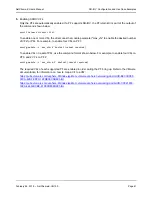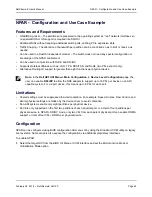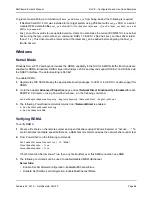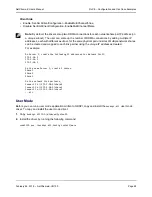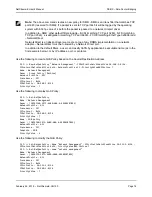
DCBX – Data Center Bridging
NetXtreme-E User’s Manual
February 26, 2018 • NetXtreme-E-UG100
Page 74
DCBX Mode = Enable (IEEE only)
This option allows a user to enable/disable DCBX with the indicated specification. IEEE only indicates that
IEEE802.1Qaz DCBX is selected.
Windows Driver setting:
After enabling the indicated options in the UEFI HII menu to set firmware level settings, perform the follow
selection in the Windows driver advanced properties.
Open
Windows Device Manager -> Broadcom NetXtreme E Series adapter -> Advanced Properties ->
Advanced tab
Quality of Service = Enabled
Priority & VLAN = Priority& VLAN enabled
VLAN = <ID>
Set desired VLAN id
To exercise the DCB related command in Windows PowerShell, install the appropriate DCB Windows feature.
1.
In the
Task Bar
, right-click the Windows PowerShell icon and then click
Run as Administrator
. Windows
PowerShell opens in elevated mode.
2.
In the Windows PowerShell console, type:
Install-WindowsFeature "data-center-bridging"
DCBX Willing Bit
The DCBX willing bit is specified in the DCB specification. If the Willing bit on a device is true, the device is willing
to accept configurations from a remote device through DCBX. If the Willing bit on a device is false, the device
rejects any configuration from a remote device and enforces only the local configurations.
Use the following to set the willing bit to True or False. 1 for enabled, 0 for disabled.
Example
set-netQoSdcbxSetting -Willing 1
Use the following to create a Traffic Class.
C:\> New-NetQosTrafficClass -name "SMB class" -priority 4 -bandwidthPercentage 30 -Algorithm ETS
Use the following in displaying the created Traffic Class:
Note:
By default, all 802.1p values are mapped to a default traffic class, which has 100% of the
bandwidth of the physical link. The command shown above creates a new traffic class to which any
packet tagged with eight IEEE 802.1p value 4 is mapped, and its Transmission Selection Algorithm
(TSA) is ETS and has 30% of the bandwidth.
It is possible to create up to seven new traffic classes. In addition to the default traffic class, there is
at most eight traffic classes in the system.


